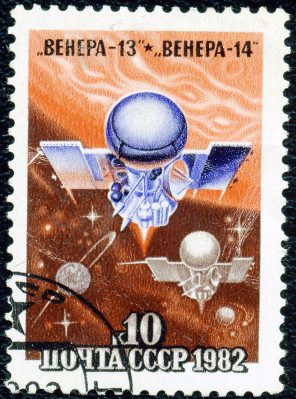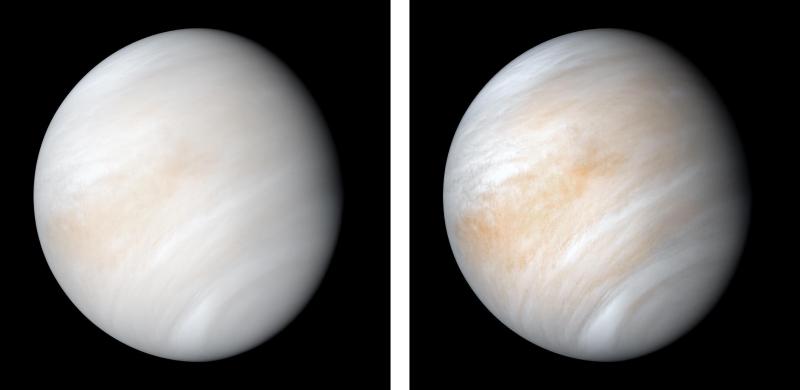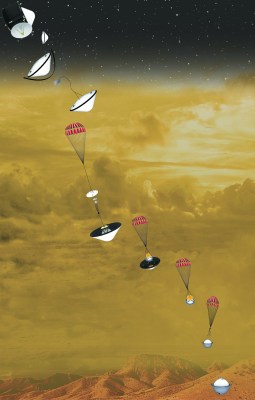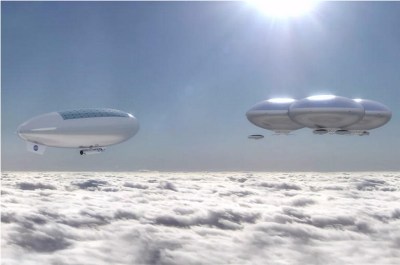Even as we bask in the knowledge that our neighboring planet Mars is currently home to a multitude of still functional landers, a triplet of rovers and with an ever-growing satellite network as well as the first ever flying drone on another planet, our other neighboring planet Venus is truly playing the wallflower, with Japan’s Akatsuki orbiter as the lone active Venusian mission right now.
That is about to change, however, with NASA having selected two new missions that will explore Venus by the end of this decade. The DAVINCI+ and VERITAS missions aim to respectively characterize Venus’ atmosphere and map its surface in unprecedented detail. This should provide us information about possible tectonic activity, as well as details about the Venusian atmosphere which so far have been sorely missing.
Despite Venus being the closest match to our planet Earth, how is it possible that we have been neglecting it for so long, and what can we expect from future missions, including and beyond these two new NASA missions?
It Wasn’t Always This Way

The 1960s saw a total of 18 missions from the USA and USSR that targeted Venus, with five successfully completed missions:
- Mariner 2 (1962, Flyby)
- Venera 4 (1967, Atmospheric)
- Mariner 5 (1967, Flyby)
- Venera 5 (1969, Atmospheric)
- Venera 6 (1969, Atmospheric)
Exploration continued in the 1970s with 11 Venus missions beginning with the Venera 7 lander, which was the first soft landing on another planet, followed soon by the Venera 8 lander. By the time the 1980s were in full swing, the Venera 13 lander was the first to send back audio recorded from the surface of Venus. Yet by the time the Vega 2 mission reported its successful landing in 1984, the USSR which had been running the Venera and Vega programs ceased their exploration of Venus. Even so the 1980s saw 8 Venus missions.
At this point in time, the closest a non-Soviet probe has come to landing on Venus was the Pioneer Venus 2 (Pioneer 13) mission from 1978 when it launched a number of probes into the Venusian atmosphere, one of which continued submitting data for a while after it had made it to the surface. After this mission, the 1989 Magellan orbiter mission was the US’s next and final Venus mission.

Although the US Galileo mission observed Venus on its way to Jupiter, this was not its primary mission, and no following US probes would perform detailed scientific observations of Venus. The Cassini and MESSENGER missions both mostly used Venus for a gravity assist, leaving the 1990s devoid of any Venus missions. It wouldn’t be until the 2000s that ESA’s Venus Express would pay Venus a visit. Even then, this ESA probe was made from reused Mars Express components rather than as a dedicated Venus mission.
Since the 2010s, Venus has become the sole domain of Japan’s JAXA, with Akatsuki (‘Dawn’) still in orbit, but beyond that nothing but telescopes pointed at our sister planet.
An Intriguing Planet
Venus is the second planet from the Sun after Mercury, followed by the Earth. Its mass is 81.5% of that of the Earth, 85.7% the volume and ~90% by surface area. Its surface gravity is 8.87 m/s2 compared to 9.80665 m/s2 for Earth. In comparison, Mars has 15.1% the volume of Earth and 28.4% the surface area, with a surface gravity of 3.72076 m/s2 which is just over twice that of the Earth’s Moon (1.62 m/s2). Effectively this means that a human on Venus would weigh nearly as much as on Earth, and the planet itself is only a little bit smaller than the Earth.
Venus also has a very dense atmosphere (9.2 MPa), much more than Earth (~101.325 kPa at sea level), and a molten core. Yet for reasons unknown, Venus does not generate a magnetic field using the core’s dynamo, as is the case on Earth. The exact state of Venus’ core and whether it has a (molten core) dynamo that could work again if the right conditions (e.g. sufficient convection) were met remains an active topic of research. All we know at this point is that Venus’ only magnetic field is generated due to the interaction between its ionosphere and the solar wind.

Exactly why Venus has such a dense atmosphere is also unknown. Its atmosphere consists of 96.5% CO2, with nitrogen and trace elements making up the rest of the composition, including water vapor (20 ppm). The relatively high levels of sulfur dioxide in the air (150 ppm) combined with the water vapor make clouds of sulfuric acid that shield the planet’s surface from Earth-based telescopes and also gives it a yellowish glow. It’s been suggested that Venus’ atmosphere is the result of a run-away greenhouse (atmospheric warming) effect, but future research will have to confirm or refute that theory.
Also fascinating about Venus is that its axial rotation is opposite to that of Earth, Mars, and all other planets in the Solar System besides Uranus. This means that on Venus the Sun rises in the west and sets in the east. Its rotational velocity is also markedly lower than that of other planets at 224.7 Earth days. All of this raises many questions about why Venus ended up in such a different state compared to Earth when evidence points to both planets having started out much more similar.
Most recently, studies of Venus’ atmosphere using Earth-based measurements have suggested that high levels of phosphine exist in its upper levels, which would be a clear sign of organic life. This might be microbial lifeforms existing in the upper regions of the atmosphere. Despite the initial phosphine findings having been refuted by other researchers, a recent follow-up refutal of the refutal reaffirms these phosphine levels and thus the tantalizing possibility of life existing on Venus.
New Venus Missions

So far the 2020s look to feature a bit of a revival in Venus missions, with five planned missions:
- Rocket Lab’s atmospheric probe (~2023).
- India’s Shukrayaan-1 (~2024/2026, orbiter).
- NASA’s VERITAS (~2028, orbiter).
- Roscosmos’ Venera-D (~2029, orbiter & lander).
- NASA’s DAVINCI+ (~2029/2030, atmospheric).
Little is known about Rocket Lab’s proposed Venus mission other than that it would likely involve atmospheric measurements. Meanwhile India’s Shukrayaan-1 mission comes on the heels of its successful Chandrayaan (Lunar) and Mangalyaan (Mars) programs. This mission is likely to be complementary to the VERITAS mission, and possibly DAVINCI+ if the proposed atmospheric probe is added.
Selected for NASA’s Discovery Program, VERITAS‘s main mission consists of measuring the surface emissivity along with using its synthetic aperture radar (SAR) instrument to create the most detailed topographical map of Venus’ surface to date. It will also carry the new Deep Space Atomic Clock-2, whose additional precision will be used to hopefully detect gravitational features of Venus using the Doppler shift of the signal between VERITAS and Earth.
Meanwhile, DAVINCI+’s mission will be to measure properties of the atmosphere which its descent probe will be plunging through, in addition to creating high-resolution photographs of features in the landscape. In particular the mission plans to gather more data on the tesserae, which can be thought of as equivalent to Earth’s plate tectonics.
The new installment in Russia’s revival of the Venera program in the form of Venera-D is perhaps the most ambitious of all these missions. In addition to repeating the Venera-13 & 14 mission profiles with landing a probe on Venus it would feature an orbiter and talks are underway with NASA to include the VAMP (Venus Atmospheric Maneuverable Platform) aircraft. The latter is a proposal by Northrop Grumman and L’Garde for what would be essentially a long-duration aircraft, capable of navigating the upper parts of Venus’ atmosphere for up to a year.
If VAMP were to be part of the Venera-D mission, it would allow for the first detailed exploration of this part of Venus’ atmosphere during a months-long mission, providing us the best chance at this point to discover the source of the suspected phosphine and possibly life on Venus.
The Final Frontier

Although these new missions will still take a number of years to materialize, with most of them likely not reaching Venus until the 2030s, the potential of what we can learn not only about Venus, but also Earth is simply too tempting. Even beyond figuring out what makes Venus tick, or perhaps rather what made it take such a different course from Earth, it’s likely one of the easiest planets we could colonize, not to mention terraform.
The coming decades we can hopefully look forward to the first Venusian rovers like NASA’s Zephyr and AREE concepts. Rovers like these may arrive before or around the time when concepts like HAVOC for floating colonies in Venus’ atmosphere become a reality. The advantage of these would be that at around 55 km altitude, the Venusian atmosphere has roughly the same pressure as on Earth at sea level, with a temperature of around 27 °C (80 °F).
Whether or not all of this will truly materialize over the coming decades is of course anything but certain, not to mention heavily dependent on politics and budget sizes of the relevant space-faring nations. Here a happy note is that Europe’s ESA has announced a new Venus orbiter mission in the 2030s, called EnVision. When a manned mission to Venus does get announced, it will probably feel like a consolation to those who had been waiting for the 1973 astronaut flyby of Venus using a Saturn V rocket.
Here is to an exciting new chapter in humankind’s history and scientific exploration.















Nicely written. Couldn’t believe, I actually read the whole of it (usually I look for shorter posts) ! Comprehensive and informative.
Floating colony would be fascinating !
“Floating colony would be fascinating !”
Yeah, I’d love to meet Lando Calrissian!
Next up, push Venus into a wider orbit around the sun to cool it down and make it habitable.
A mission to grab a load of rocks from the asteroid belt and slam them into Venus. Pool with planets it is.
Orbit is not the problem, problem is enormous atmosphere. To make Venus habitable you have to find out how to make its atmosphere close (at least in pressure on surface) to the Earth’s one. As soon as you do it, you will have to wait cooling of surface. With high probability, orbit change will not be necessary to get acceptable temperature and pressure conditions on high latitudes. Also, you could make atmosphere slightly thinner and keep greenhose effect to lower temperature gradients. This could add more habitable surface, but with lower pressure. So, there are no need to change Venus orbit, unless you plan to populate every square mile of Venus surface.
The proposals to habit Venus involve putting big floating platforms in the upper atmosphere, basically huge hot air balloons that ride the point where the pressure is close to earth.
Of course this won’t work, since the atmosphere is not going to be all calm and stratified all the time. One good storm and your floating city is gone.
Not to mention, even if you do build an floating platform – then what? You have no access to the surface, so you have no access to building materials or other resources. All you have is air. Everything needs to be brought in from earth at a gargantuan cost, so the best you can hope for is a robotic research platform. Anyone going there would be on a suicide mission, because you can’t build or launch a rocket big enough to get back while floating up there, and the floating platform itself is just one big storm away from destruction.
Well, you do have unlimited access to carbon dioxide. Organic synthesis would be an option. I think a colony would start looking like a treehouse pretty quickly.
If you go high enough in the atmosphere you can get to a comfortable temperature but I think the death knell for a Venus colony would be radiation, though. Almost twice the solar radiation without a sufficient magnetic field for protection and with most of the atmosphere beneath (not protecting) you, I think life is going to be difficult.
guys. whats wrong with terra forming the sahara or northern canada? start “small” and scale up.
How about some thermal transfer pipes between those locations and some much warmer locations? Would be a trivial project compared to building anything substantial in space.
I’ll bet it would be cheaper and faster to just put some mirrors in orbit: reflect sunlight away from hot areas, reflect some down to cold areas. It would certainly be less mass in mirrors than pipeline material. I’d wager there would be less mass in the total orbital system, including launch vehicles, then there would be in pipelines.
Would totally suck for the night sky though.
Lordy, lordy HaD, where’s the edit button?
*than*, not *then*. My fingers can’t type, and they’re making me look like an illiterate twit.
Better to screw up your first few attempts at geoengineering on dead planets than to do so on our only current habitable one. Make a mistake on Mars or Venus and you can just try again.
Save Earth until we really know what we are doing with experience.
A little late for than, no?
Extincting the indigenous highly adapted lifeforms would be a big no no for me in such a situation
Agree. It’s taken humans hundreds of years to terraform earth and arguably we’ve been as efficient as the economy allows ;)
I say this not to derail the conversation; I just don’t think terraforming should be the goal of research in planetary science – not for a long while yet
Kurzgesagt’s latest video is about exactly this:
https://www.youtube.com/watch?v=G-WO-z-QuWI
If you slam enough rocks into Venus hard enough to move it I don’t think living there is going to be very appealing for quite a long time, you’d have to wait for it to solidify again.
I think it would be a great idea to head on up to Enceladus, gather up some ice, and start tossing snowballs downhill at Venus. A 10,000 tonne ice block (the size of a school gym) once per second for a few centuries would be a good start: Aim it at the equator on the sunward side, and it will a) spin up the planet to shorten the day, b) blow off some of the excess atmosphere, c) move the whole darned planet a bit further away to a cooler neighborhood, and d) make the beginnings of a small sea.
You could fabricate solar sails from lunar regolith at L5, send them on out to Enceladus to collect ice, and deliver it to Venus. Or use the solar sails to concentrate power for a mass driver near Saturn — may be quicker and require fewer sails.
If we have the resources to make that quantity of solar sails, it’s just a tiny stretch to make a sunshade for the whole planet, to further accelerate cooling and collapse of the atmosphere (water + CO2 + miscellaneous elements; mix & allow to cool = rock, accelerated by seeding the atmosphere with biologics).
In a few centuries we could have another nice planet to live on. Another basket for the eggs.
Downhill? That’s not how orbits work. The difference in energy between one orbit and another, that’s what you need to move mass between them. It doesn’t matter that it is “downhill”.
To move enough mass to matter would either require an unimaginable number of solar sails each moving negligible quantities or ridiculously large ones at scales so far known only to really bad movie equals. (looking at you Independence Day).
I think you might have just allocated the entire crust of our moon for your one project.
“The difference in energy between one orbit and another, that’s what you need to move mass between them. ”
Correct, if you want to match velocities.
But absolutely not true if you just want to get the mass there, especially if you want it to arrive with a good impact speed to transfer momentum and blow off some excess atmosphere. You just need to cancel most of Saturn’s orbital velocity (10 km/s), though you also have to lob the stuff out of Enceladus’ & Saturn’s gravity well too, so a total of somewhere around 16 km/s. Then just wait around a decade or so for it to fall downhill.
And, yes, an awful lot of material will be needed for the sails. Which is why I suggested the alternative of just using the solar energy directly and use some fraction of the payload in a mass driver.
Though I’d hate to be that new kid in the galactic civilization, polluting the neighborhood with all the dirty exhaust from those mass drivers.
BTW is that another Joe Kim piece? I love the Deco aesthetic.
Agreed very nice piece of work
> it’s likely one of the easiest planets we could colonize, not to mention terraform.
How??
The most plausible proposals involve permanent floating platforms in the upper atmosphere above the sulfuric acid clouds, which will be subject to storms and have a very low chance of permanent survival at any rate. The next stage to live on the ground involves somehow reducing the global air pressure by a factor of 100 by some magic trick.
Living in the vacuum of space is easier than living on Venus.
Living on Venus gives you unlimited supply of O2. That’s nothing the vacuum of space can offer you. You also have an unlimited supply of Carbon. And getting some H from there as well won’t also be this hard, compared to the vacuum of space. So, no. Living on Venus will be much easier b/c you’ll have plenty of material right in front of you without any transportation costs.
PLenty of C and 0, Not so plenty amounts of H S and N and some noble gases. So far I havent found any mention of meaningful amounts of Na and Cl. It would be a gargantuan project to get a floating station operational and i honestly do not see the benefits.
I would nice if they started making CO2 ice balls and shot them into the path of Mars. We could give Mars a nice atmosphere to warm it up and make Venus a little cooler at the same time.
That would require a LOT of energy.
What about this — at the surface there’s an ample supply of heat, yet in space (out of the sunshine) it’s about 2.7K. Now imagine a closed hollow cylinder standing on the surface, tall enough to get up where the sky is clear and black. In the hollow space, a suitable quantity of water such that it condenses at the top end, runs down, boils and flows back up. Basic Victorian-era steam heating wrought large in Unobtanium. Even on the day side, that’s a 380K delta, but on the night side, more like 690K.
Well that’s obviously not something that we could build, but supposing you have a floating platform, you could conceivably hang a scaled down version of that below you, and radiate the heat off the top of the thing. You probably couldn’t build upward b/c you’d need to keep the center of buoyancy above the c-of-g or you’d roll. Using practical materials, not sure if it could be made long enough to span enough temperature drop. Anyway, a thing like that would probably be best situated at an altitude where the temperature gradient is steepest, in order to pick up the most degrees per meter.
Assuming it’s even practical (and I can’t even begin to model this well enough to tell), you’d have a system to drain heat off the planet. Just passively letting heat away into space to cool the place down would be worthwhile enough. But thermodynamics tells us where there’s a heat flow, there’s energy to harvest, energy to run machines. Now all we need is a machine to turn CO2 into high quality graphene and cool refreshing O2, and things would definitely be looking up.
I can dream, can’t I?
It won’t work.
Two words: “adiabatic atmosphere”
As the water vapor rises it will expand and cool, and be cold by the time it reaches the top of the atmosphere.
Yes, b/c obviously the open atmosphere works that way, and that’s stable (or appears to be), any sizable column would probably behave the same. I’m talking about pure water, probably at quite low pressure. Or maybe CH4 or NH3, whatever you could get in quantity from asteroids or whatever, contained in pipes probably not more than a meter or two in diameter. At pressure such that you get phase changes – boiling at the bottom, condensing at the top. Idk, maybe it’s the necessary vertical span that kills it? Could skip the phase change, work with gas throughout, and drive it with a pump if need be.
How can a planet smaller than earth have an atmosphere 100x denser? What keeps the atmosphere from flying away if there is less gravity
The jury still seems to be out on that one.
Gravity on Venus is essentially the same as Earth, within 10%.
Venus, because it has no magnetosphere, you’d expect to see solar wind stripping more atmosphere.
CO2 is heavier than air, but only 1.4 times as much, so that seems unlikely to account for the 90x difference.
But volcanism on Venus may be replenishing CO2 faster than the solar wind strips it.
CO2 was also removed from Earth’s primordial atmosphere and turned into carbonate rocks by the plentiful water here. But water on the hotter Venus boiled away (water vapor is lighter than air), so the CO2 was not removed by that mechanism.
The Earth’s moon also may have helped strip atmosphere away, particularly in the primordial times, when it was much closer and the tides were much higher.
Kurzgesagt did a video on terraforming venus recently:
https://youtu.be/G-WO-z-QuWI
Tl;dr- several impossible technologies would be required to generate an enormous flow of energy to make it habitable.
Seems planets are a lot like houses, easier to heat than cool, entropy and such.
We should definitely try, countless scientific leaps will be made in the course of trying (many useful for undoing our damage to earth), but I’m not holding my breath on humanity living there within 5 generations.
Redirect an asteroid to hit the atmosphere at a small angle, to blow some of it into space, repeat as many times as it takes. Maybe the lost atmosphere will create a gas moon. Also construct a space mirror to block out most sunlight, then maybe in a thousand years or so you have something that is worth working with.
A better strategy would be to mine those asteroids for calcium oxide (both elements are quite abundant according to NASA) A.K.A. quicklime and pelt the Venusian atmosphere with trillions of pellets of the stuff. CaO + CO2 + heat (from reentry) will produce limestone (CaCO3), sequestering the carbon as rock. The remaining unused parts of the donor asteroid should also be sent into orbit around Venus with the goal of amassing enough material to form a large enough moon to match the early Earth’s. Why try moving a single body large enough in one go when it’s more practical to send the same amount of matter as a stream of manageable chunks?
A large moon orbiting Venus would cause ‘body tides’ that would flex it’s crust and impart heating in the mantle. Heating the mantle would lead to the convection currents that are necessary to generate a magnetic field. The Earth’s crust flexes over 20″ due to the Moon’s gravity.
https://en.wikipedia.org/wiki/Earth_tide
We know that the Earth’s gravity is responsible for tidal heating of the Moon’s mantle. It’s reasonable to assume that the moon is likewise contributing to the Earth’s mantle staying hot as well.
https://www.sciencedaily.com/releases/2014/08/140808110715.htm
Conventional wisdom has maintained that the Earth’s mantle is kept hot from the decay of heavy elements, and that the moon’s role in heating is insignificant. There is however new models emerging that account for the Moon’s energy contribution to mantle heating from gravity.
https://www.sciencedirect.com/science/article/pii/S0012821X16301078
Having a large moon would have a second benefit. Venus currently rotates once every 243 days. Having a large moon that orbited faster and closer would drag Venus, shortening it’s day. Tidal deceleration can be leveraged to impart changes on a planetary scale by strategically moving a large number of relatively small units of mass.
Imagine how much we would know about our solar system if Lyndon Johnson had supported the Apollo Applications Program instead of having a big ugly war.*
*OK, there were some social programs that also took some of the funding. These were a better investment than wars in SE Asia.